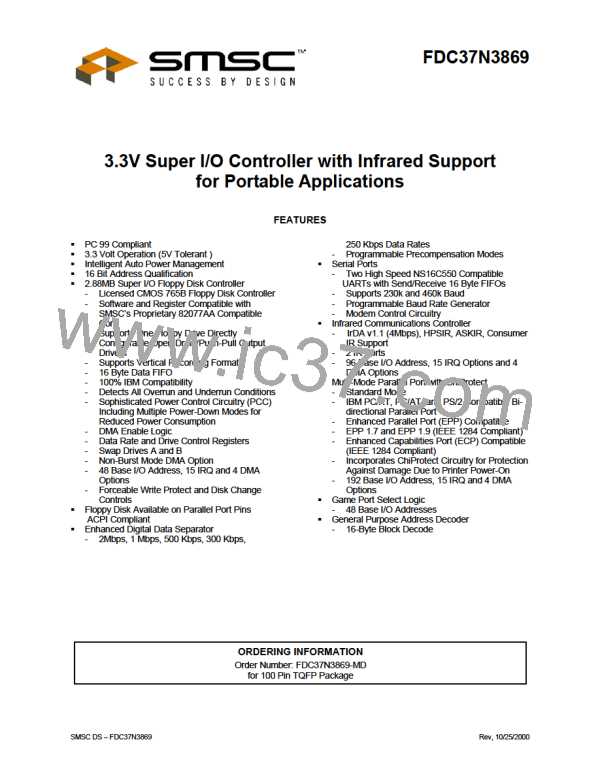EPP DATA PORT 0
ADDRESS OFFSET = 04H
The EPP Data Port 0 is located at an offset of ‘04H’ from the base address. The data register is cleared at
initialization by RESET. During a WRITE operation, the contents of DB0-DB7 are buffered (non inverting) and output
onto the PD0 - PD7 ports, the leading edge of nIOW causes an EPP DATA WRITE cycle to be performed, the trailing
edge of IOW latches the data for the duration of the EPP write cycle. During a READ operation, PD0 - PD7 ports are
read, the leading edge of IOR causes an EPP READ cycle to be performed and the data output to the host CPU, the
deassertion of DATASTB latches the PData for the duration of the IOR cycle. This register is only available in EPP
mode.
EPP DATA PORT 1
ADDRESS OFFSET = 05H
The EPP Data Port 1 is located at an offset of ‘05H’ from the base address. Refer to EPP DATA PORT 0 for a
description of operation. This register is only available in EPP mode.
EPP DATA PORT 2
ADDRESS OFFSET = 06H
The EPP Data Port 2 is located at an offset of ‘06H’ from the base address. Refer to EPP DATA PORT 0 for a
description of operation. This register is only available in EPP mode.
EPP DATA PORT 3
ADDRESS OFFSET = 07H
The EPP Data Port 3 is located at an offset of ‘07H’ from the base address. Refer to EPP DATA PORT 0 for a
description of operation. This register is only available in EPP mode.
EPP 1.9 Operation
When the EPP mode is selected in the configuration register, the standard and bi-directional modes are also
available. If no EPP Read, Write or Address cycle is currently executing, then the PDx bus is in the standard or bi-
directional mode, and all output signals (STROBE, AUTOFD, INIT) are as set by the SPP Control Port and direction is
controlled by PCD of the Control port.
In EPP mode, the system timing is closely coupled to the EPP timing. For this reason, a watchdog timer is required to
prevent system lockup. The timer indicates if more than 10µsec have elapsed from the start of the EPP cycle (nIOR
or nIOW asserted) to nWAIT being deasserted (after command). If a time-out occurs, the current EPP cycle is
aborted and the time-out condition is indicated in Status bit 0.
During an EPP cycle, if STROBE is active, it overrides the EPP write signal forcing the PDx bus to always be in a
write mode and the nWRITE signal to always be asserted.
SOFTWARE CONSTRAINTS
Before an EPP cycle is executed, the software must ensure that the control register bit PCD is a logic “0” (i.e. a 04H
or 05H should be written to the Control port). If the user leaves PCD as a logic “1”, and attempts to perform an EPP
write, the chip is unable to perform the write (because PCD is a logic “1”) and will appear to perform an EPP read on
the parallel bus, no error is indicated.
EPP 1.9 WRITE
The timing for a write operation (address or data) is shown in timing diagram EPP 1.9 Write Data or Address cycle.
IOCHRDY is driven active low at the start of each EPP write and is released when it has been determined that the
write cycle can complete. The write cycle can complete under the following circumstances:
1) If the EPP bus is not ready (nWAIT is active low) when nDATASTB or nADDRSTB goes active then the write
can complete when nWAIT goes inactive high.
2) If the EPP bus is ready (nWAIT is inactive high) then the chip must wait for it to go active low before changing
the state of nDATASTB, nWRITE or nADDRSTB. The write can complete once nWAIT is determined inactive.
SMSC DS – FDC37N3869
Page 73
Rev. 10/25/2000

 SMSC [ SMSC CORPORATION ]
SMSC [ SMSC CORPORATION ]